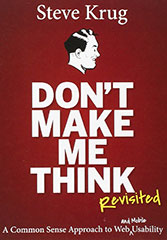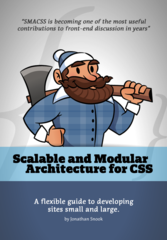Books, Books, Books
18 November 2014
Voracious reader that I am I've been doing my best to supplement the course material I've been given with other texts to help me understand the field I'm getting into. Much of this reading happens on blogs and other online publications, but I've picked up a handful of books too. Some of these have been particularly good reads, so I thought I'd share my thoughts on them. Here they are in reverse chronological order.
Don't Make Me Think, Revisited:
A Common Sense Approach to Web Usability

This book's primary target audience is in-house web developers at large organizations. It provides strategies for good user experience (UX) design, and for convincing other stakeholders of the need for good UX design.
Rather than a rule book, it's a book structured on the application of a few core principles, most of which seem like common sense. To quote Krug's trademarked phrase, "It's not rocket surgery."
The priciples might be summarized as: simplify, shorten and make everything abundantly obvious. The title "Don't Make Me Think" is the user's exhortation to the designer. Krug makes a point of disabusing the reader/designer of the notion that the end user will take the time to appreciate the work put into the website. When we visit a website we scan rather than read and we navigate by trial and error.
As common sense as this book may be. I can see myself revisiting it from time to time as a refresher when I need to think about the end results of my design.
Scalable and Modular Architecture for CSS:
A flexible guide to developing sites small and large

Having only worked on small websites in class I haven't had to think much about scalability. This book made me do that. Snook points out many of the common pitfalls and problems that a CSS developer will encounter as a website grows.
Prior to reading this book I was organizing my stylesheets in a manner that attempted to mirror my HTML markup, with header, body and footer styles. The scalable and modular architecture for CSS (SMACSS) approach is to develop according to a hierarchy. This prevents specificity issues which are always a pain to debug, and makes it easier to separate style that will apply to multiple pages from styles that are page specific.
Since reading the book the first time I pull it out whenever i start a new stylesheet to keep Snook's organizational structure in mind.
Sass for Web Designers

Having previously read Ethan Marcotte's Responsive Web Design and wanting to start writing my stylesheets in SASS, this primer from A Book Apart seemed like a good place to turn.
As it turns out, if you're familiar with CSS learning SASS is pretty easy, and Cedarholm gave me all the information I needed to get up and running. I've been using variables, operators, and nesting extensively in all my recent projects and I'm sure I'll pick up this book again if I want to start doing fancy things with mixins.
Responsive Web Design

I read this book the first week of class and it really gave me a jumpstart on how I wanted to go about designing all of my projects. Marcotte sold me on his responsive philosophy in the first chapter and gave me just enough code in the subsequent ones to give me a handy reference on how to make my first project responsive.
I am exceptionally glad I opened this book early on. It helped me start off on the right foot with my design. Had I happened upon it later, I might have had to rid myself of some bad habits.
